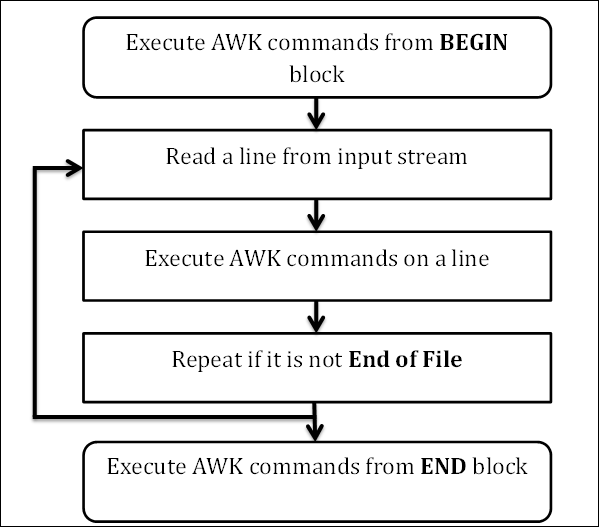
- AWK Tutorial
- AWK - Home
- AWK - Overview
- AWK - Environment
- AWK - Workflow
- AWK - Basic Syntax
- AWK - Basic Examples
- AWK - Built in Variables
- AWK - Operators
- AWK - Regular Expressions
- AWK - Arrays
- AWK - Control Flow
- AWK - Loops
- AWK - Built in Functions
- AWK - User Defined Functions
- AWK - Output Redirection
- AWK - Pretty Printing
- AWK Useful Resources
- AWK - Quick Guide
- AWK - Useful Resources
- AWK - Discussion
AWK - Workflow
To become an expert AWK programmer, you need to know its internals. AWK follows a simple workflow − Read, Execute, and Repeat. The following diagram depicts the workflow of AWK −

Read
AWK reads a line from the input stream (file, pipe, or stdin) and stores it in memory.
Execute
All AWK commands are applied sequentially on the input. By default AWK execute commands on every line. We can restrict this by providing patterns.
Repeat
This process repeats until the file reaches its end.
Program Structure
Let us now understand the program structure of AWK.
BEGIN block
The syntax of the BEGIN block is as follows −
Syntax
BEGIN {awk-commands}
The BEGIN block gets executed at program start-up. It executes only once. This is good place to initialize variables. BEGIN is an AWK keyword and hence it must be in upper-case. Please note that this block is optional.
Body Block
The syntax of the body block is as follows −
Syntax
/pattern/ {awk-commands}
The body block applies AWK commands on every input line. By default, AWK executes commands on every line. We can restrict this by providing patterns. Note that there are no keywords for the Body block.
END Block
The syntax of the END block is as follows −
Syntax
END {awk-commands}
The END block executes at the end of the program. END is an AWK keyword and hence it must be in upper-case. Please note that this block is optional.
Let us create a file marks.txt which contains the serial number, name of the student, subject name, and number of marks obtained.
1) Amit Physics 80 2) Rahul Maths 90 3) Shyam Biology 87 4) Kedar English 85 5) Hari History 89
Let us now display the file contents with header by using AWK script.
Example
[jerry]$ awk 'BEGIN{printf "Sr No\tName\tSub\tMarks\n"} {print}' marks.txt
When this code is executed, it produces the following result −
Output
Sr No Name Sub Marks 1) Amit Physics 80 2) Rahul Maths 90 3) Shyam Biology 87 4) Kedar English 85 5) Hari History 89
At the start, AWK prints the header from the BEGIN block. Then in the body block, it reads a line from a file and executes AWK's print command which just prints the contents on the standard output stream. This process repeats until file reaches the end.